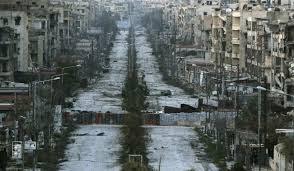Putin Loves Syria-can help to make Russia Cold again but Putin Hot
 |
| Syria (pic .by newsweek) |
Nature abhors a vacuum, but Vladimir Putin really loves one. The Russian president clearly sensed a big power void in Syria, where the civil war has intensified and where the United States has neither committed ground forces nor devised a compelling strategy to settle the conflict or defeat the Islamic State. Although the Islamic State has rampaged through Iraq, its headquarters is in Syria.
Into that vacuum, Putin has sent a substantial force of tanks, armored personnel carriers, air defense systems and upward of two dozen combat aircraft over the past several weeks. Russia is also building enough housing for 2,000 people, U.S. officials have said. What to make of Russia’s muscling into the war-torn country? For Putin, there are essentially five reasons, moving from the broadly strategic to the purely tactical.
Making Russia a Great Power Again. Gaining a pivotal role in the Middle East would be an important way station on the road to Putin’s overarching goal — restoring Russia to great-power status. The Syria problem allows him to vividly contrast Russia’s activism with what many see as Washington’s hesitation and timidity. Count on Putin to present himself as the regional peacemaker when he speaks at the U.N. today.
Shoring Up Assad … or His Successor. The Syrian president, Bashar al-Assad, has been Russia’s only real ally in the region; Syria hosts Russia’s sole warm-water seaport at Tarsus. But Assad is weakening, particularly under assaults from the Islamic State, and now controls only about a sixth of the country. By establishing a ground presence, Russia hopes not only to increase Assad’s chances of surviving but also — equally important — to be in a position to influence the succession if he does not. More on this in a minute.
 |
| Syria’s Assad and Putin |
This clear Russian interest contrasts with the more complex calculus the U.S. has faced. By virtue of opposing both Assad and the Islamic State, Washington has been paralyzed by the simple reality that opposing one of them inevitably helps the other. The U.S. has yet to devise a strategy that avoids this Hobson’s choice.
Regional Influence. Military intervention gives the Russians an opportunity to tighten relations with Iran, which shares Russia’s desire to prop up the Assad regime. Already Iran has military advisers and proxy forces — Hezbollah militia fighters from Lebanon — on the ground in Syria. Not that Putin is depending solely on Iran: Russia has played regional power broker for months in the run-up to the Syria deployment, hosting consultations in Moscow with leaders from Saudi Arabia, Jordan, Egypt, Turkey, Israel, Palestine and Iran.
Hammering on the Islamic State. Putin genuinely wants to defeat the Islamic State. Russia says about 2,400 of its nationals are fighting with the IS; chances are, many of them are from Russia’s Caucasus region, which has a large Muslim population and hosts a number of separatist movements. Returning Russian fighters would pose a direct threat to Russia’s control in key parts of its southwest.
When in Doubt, Distract. Activism in Syria gives Putin a way to distract attention from Russia’s aggression in Ukraine. At the same time, it obliges the Western coalition opposing the Islamic State to work directly with Russia. At minimum, the U.S.-led coalition has to de-conflict military operations with Russia, but inevitably, that will begin to draw it into a cooperative relationship with Moscow. That will only muddy the waters when it comes to the West’s Ukraine grievances.
Although Russia’s broad objectives are clear, its precise plans in Syria are not. Its major fear is probably that the Assad regime will fall to some combination of extremists dominated by the Islamic State, thus depriving Moscow of its closest ally in the region. Faced with that fear, Russia could pursue one of two paths. Together with Iran, it could go all out to preserve Assad in power, concentrating its firepower on the Islamic State — and perhaps even on the more moderate rebels the West tends to favor.
On the other hand, Russia may have concluded that Assad’s crumbled legitimacy — due to the horrors his regime has inflicted on his own people — makes it unrealistic to preserve the regime in its present form. It may thus settle on a more modest objective: Prevent a total breakdown of order by preserving the rough form of the Syrian state while easing Assad out gradually in favor of some other, more acceptable ruler. The latter scenario is not far off from what the United States and the United Nations have been trying unsuccessfully to achieve in Syria. So if events move in that direction, there could be scope for cooperation between Russia and the West on a phased strategy, working first to destroy the Islamic State and then deciding what to do about the Assad regime.
In the end, the main thing Russia gains from its deployment is enhanced leverage over what becomes of Syria. At the same time, the limitation of U.S. efforts to an air campaign and the failure of its program to train a large force of moderate rebel fighters mean that the U.S. has lost leverage and will have less influence over the course of events in Syria. In short, Putin is forcing the U.S. to work with him and ensuring that he will have a large voice in determining the future of the Middle Eastern capital that means the most to Russia.
The author was acting director and deputy director of the CIA from 2000 to 2004 and now teaches at the Johns Hopkins School of Advanced International Studies.


Comments